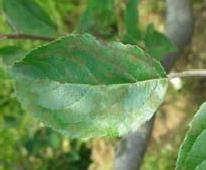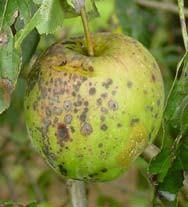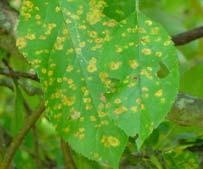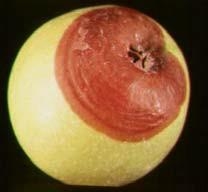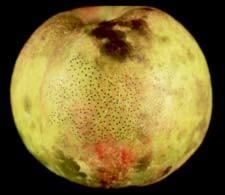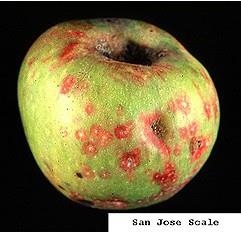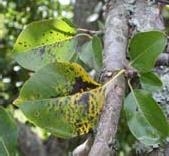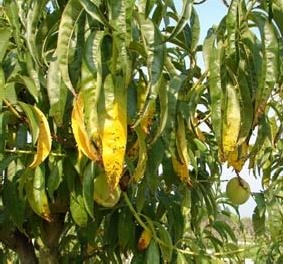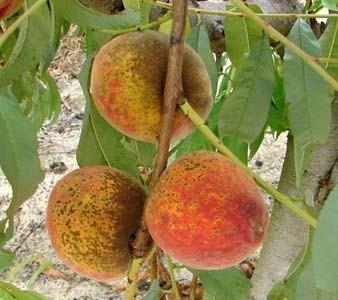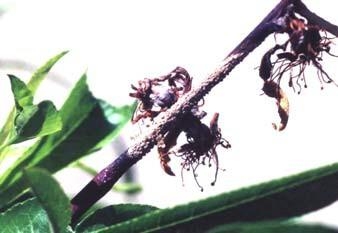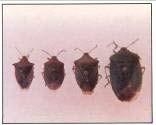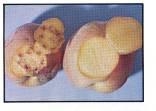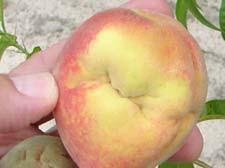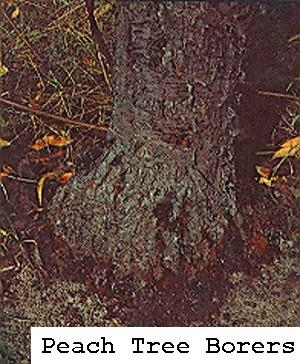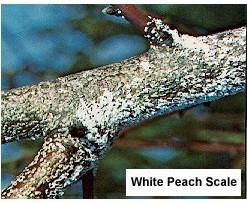Homeowners who grow fruit in their yards or small orchards find that disease and insect pests often ruin the crop and in some instances damage the tree itself. Some years it may be possible to grow acceptable fruit without the use of pesticides, but in most years a few well-timed insecticide and fungicide sprays are needed. The effects of many pest problems can be reduced if several things are considered prior to buying and planting fruit trees.
For information about growing fruit trees, consult the North Carolina Production Guide for Smaller Orchard Plantings.
One of the most important factors for producing fruit is selection of an area suitable for growing fruit trees. Fruit trees perform best in full sunlight and moist but well-drained soil having a pH of 6.0-6.5. If environmental conditions are not suitable for growing fruits, pest and disease problems are more difficult to manage and in some instances cannot be managed. Additionally, fruit quality will be poor.
Second only to having a good location, is the selection of fruits and fruit cultivars that are adapted to the growing conditions in your area of North Carolina. Your county extension agent can usually tell you what fruits and which cultivars of these fruits are best suited for your area. It is important to buy only quality trees that are disease and insect free. Also check the roots to be sure they have not been allowed to become dry. Large is not always better; a tree 2-4 feet in height is much easier to establish than a taller tree. Furthermore, most fruit trees should be cut-back to a height of 2-4 feet when planted, and the new growth trained. Planting a smaller tree reduces stress on the root system allowing the tree to become established during the first year after planting. Planting should occur in late fall to late winter, November to March depending on the location in North Carolina. Some fruits such as cherries are not well adapted to the mild conditions in parts of North Carolina partly due to lack of sufficient chilling requirements.
Once trees are planted, they require regular maintenance. Fruit trees need to be properly trained and annually pruned so that sunlight can penetrate through the tree. Pruning should also be done to remove damaged and diseased wood and to stimulate new growth. Pruning out dead wood and removal of mummied fruit is the most important cultural practice done to reduce losses to diseases and insects.
Fertilization and lime application to maintain proper tree growth and soil pH are usually necessary yearly. The goal of fertilization is to produce adequate tree growth to support a quality fruit crop, not to produce excessive growth. Trees that have been established for several years and growing in heavy-textured soil may require little or no yearly fertilization. Apply the fertilizer in a circle around the tree at the drip line (outer edges of the branch canopy). Applying the fertilizer at the base of a newly plant may kill the tree. A grass and weed-free area around the tree should be maintained particularly during the first few years of tree establishment. Heavy mulching may lead to problems such as retaining excess water resulting in root rots and an environment conducive for destructive insects and other pests such as small rodents that can damage the tree trunk and root system.
Although the amount of pest injury can vary from year to year depending on environmental conditions, certain fruit are more likely to have problems than are others. Stone fruits (Prunus spp., eg., peaches, nectarines, and plums) generally require more care than pome fruits (eg. apples and pears). In general, tree fruits requiring the most care to those requiring the least are nectarine, peach, cherry, plum, pear and apple.
Conditions favoring disease development or insect occurrence vary depending on the particular disease or insect. Generally, warm, rainy or damp conditions are very conducive for the development of tree fruit diseases. For best control of diseases, fungicides should be applied before rainfall but allowing at least 2-3 hours for spray material to dry. There are specific times of the year when certain pests can most easily be controlled. Also during the growing season, at certain stages of tree growth, fruit are more susceptible to particular diseases and insects and damage is likely to be greater than during other times of the growing season. Knowledge of these conditions can greatly reduce the number of unnecessary sprays and reduce fruit losses.
During harvest, fruit should be picked before becoming over-ripe. No fruit should be allowed to remain on the trees after ripening. All fruit should be picked and if not consumed, removed from the fruit-growing area. This helps reduce many disease and insect problems for later-ripening fruit. Rake and remove all dropped fruit and leaves after leaf fall, which will reduce the likelihood of many diseases and insects the following year. Use of rigorous cultural and sanitation practices can usually reduce diseases and insects, and thus reduce the number of sprays needed and increase quality of fruit harvested.
The pesticides selected for suggested use were chosen because they are relatively safe to the user and the environment near the home, effective against a wide range of fruit diseases and insects and are usually available at many garden centers. For individuals with only a few trees, the combination fruit sprays available at garden centers may be most convenient. Some fungicides for use on fruit trees contain copper, which is an effective fungicide but the foliage and some fruit of most fruit trees is quite sensitive to copper and may cause leaf and fruit spots and defoliation. Remember, handle pesticides with care as pesticides are designed to kill pests and they should be used, stored, and disposed of only as instructed on the container label. Always read and follow the directions on the container label before using the pesticide.
Apples
DISEASES:
During the early part of the growing season (initiation of new leaf and flowers through fruit set growth stage), apple scab, powdery mildew and fire blight are the primary disease problems. Apple scab affects both the foliage (Figure 1) and fruit (Figure 2) and infections can result in defoliation and malformed fruit. Powdery mildew primarily affects the foliage and is characterized by white fungal growth on the surface of affected leaves. Fire blight, a bacterial disease, can be particularly destructive during the bloom period, causing blossom blight and shoot and branch dieback as the bacteria grow from the blossoms into the shoots (Figure 3). In the Piedmont and Coastal Plain, cedar apple rust can be destructive on susceptible cultivars when they are grown in close proximity to the Eastern red cedar (the alternate host of the fungus on which cedar galls (Figure 4) develop). Rust infections are characterized by yellow spots on the leaves and fruit that are first visible a few weeks after bloom (Figure 5). During the summer, bitter rot (Figure 6), black rot (Figure 7) and white rot, can be destructive as fruit ripen, particularly in poorly pruned trees with dead wood within the tree. One of the most common disease complexes during the summer period is sooty blotch and flyspeck (Figure 8). The fungi that cause these diseases grow on the cuticle of the fruit, but do not cause damage to the fruit themselves.
For control of fungal diseases, apply captan + sulfur when the first green tissue is visible in the spring and repeat at 7-10-day intervals until blossoms begin to open. Captan is more effective than sulfur against most apple diseases but acceptable apples can be produced with sulfur, although sprays will need to be applied more frequently than the combination of captan + sulfur. DO NOT spray an insecticide during bloom because insecticides can kill bees and other pollinating insects. However, spraying with streptomycin or copper just before rainfall during bloom at the rate of 1 teaspoon per gallon of water (0.8 oz streptomycin per 10 gallons) can aid in the control of fire blight.
When flower petals begin to drop, make a fungicide and insecticide application and repeat at 2 to 3 week intervals until 3 weeks before harvest. Use a 2-week spray interval if weather conditions are wet or there have been disease or insect problems in past years. You do not need to include sulfur in sprays with captan, beginning about 1 month after petal fall. Where cedar apple rust is a problem, include myclobutanil (sold under various trade names) in the sprays beginning at tight cluster and continuing for one month after bloom. If myclobutanil is used, you do not need to include sulfur in the spray program.
INSECTS:
San Jose scale (Figure 9) is a common orchard insect pest that can kill trees within a few years if not controlled. The use of a horticultural oil (applied at 3% solution), just before or when buds begin to show green in the spring is highly effective against scale insects. The plum curculio and oriental fruit moth are also common insect pests that often require control at petal fall. Both insects lay eggs directly in small fruitlets, with plum curculio damage causing a scarring of the fruit and oriental fruit moth larvae boring into the apple. Other insect pests that can directly injure fruit during the season include the codling moth, which is present in May and June, and the apple maggot that can be present from mid-July through mid-August. Indirect pests (i.e., those that feed on the leaves) that may occur include a number of different aphid species, which are common during the first 6 weeks after bloom and are a concern on small, newly planted trees. The European red mite can cause bronzing of leaves and is most common during June and July especially during periods of dry weather.
Insecticide active ingredients (sold under various brand names) available for the home orchard are shown in the table at the end of this document. When choosing an insecticide to apply, be sure to match the correct product with the target pest to be controlled.
Pears
DISEASES:
Pears are affected with many of the same diseases as apples with the exception of cedar apple rust, which does not occur on pears. Fire blight tends to be more severe on pears than apples and can kill large limbs and even entire trees of susceptible cultivars; Bartlett is highly susceptible. Pear leaf spot (also called fabraea leaf spot) can be important on some cultivars (Figure 10).
Captan is not registered for use on pears. Use thiophanate methyl at 2 teaspoons per gallon of water (6 2/3 tablespoons per 10 gallons). Use the same fungicide spray schedule for pears as described above for apples, excluding captan.
INSECTS:
Pears have a few additional insect pests beyond those mentioned for apple, most notably the pear psylla. The most opportune time to control psylla on pear is before bloom with an oil application, both as a dormant and delayed dormant (when green buds begin to appear) application. Pear leaves are highly susceptible to damage by mites, including two-spotted spider mite, and the pear blister and pear rust mites. The use of horticultural oils after bloom at 1% solution can help to suppress mite populations. The codling moth and oriental fruit moth can both be serious pests of pears.
Peaches and Nectarines
DISEASES:
The most common diseases encountered on peaches and nectarines are leaf curl, peach scab, and brown rot of fruit (the same fungus also causes blossom blight). Bacterial spot can cause significant fruit loss on some varieties in some locations. A bacterial disease, bacterial spot, affects both leaves (Figure 11) and fruit (Figure 12). First symptoms on fruit may be confused with peach scab (Figure 13) or chemical spray injury. Bacterial spot is best managed by planting tolerant varieties. It is more of a problem in the eastern third of North Carolina where peaches and nectarines are planted in light, sandy soils. A copper material applied in late autumn (late October – mid-November) and in early spring at budswell and again just before blossoms open may reduce bacterial spot as well as control leaf curl.
Leaf curl (Figure 14) can be controlled with a single application of Bordeaux mixture, fixed coppers or lime-sulfur (use rates recommended on product label). The spray for leaf curl must be applied during the dormant season before buds swell in late winter (usually February-March). This spray may be applied in the autumn once most of the leaves have dropped. Some cultivars of peaches and nectarines are less susceptible to leaf curl than are other cultivars. Peach and nectarine foliage is very sensitive to copper and can be injured and defoliation may occur, thus copper should not be sprayed in late spring and summer when leaves are present.
To control peach scab, captan or sulfur sprays should be started at petal fall and repeated every 7-10 days for approximately 4 weeks. Chlorothalanil also is very effective against peach scab. Once scab lesions are observed, sprays will not be effective because the infections occurred during the 4-week period after petal fall. Chlorothalanil is best used in the place of captan + sulfur in the first 1 or 2 sprays of the season as injury to leaves may occur when used later and should not be used after fruit set. Peaches and nectarines that ripen mid-July or later should continue to be sprayed with captan (more effective) or sulfur every 3-4 weeks. These fungicides can be applied in combination with the post-bloom insecticides
If weather conditions are wet and brown rot (Figure 16) has been a problem previously, 2 to 3 applications of captan or sulfur should be used starting 3 weeks prior to anticipated harvest. Use a formulation labeled for bearing fruit trees that does NOT contain an insecticide. If sulfur is used for brown rot control, spray every 5 to 7 days starting 3 weeks before anticipated harvest when weather conditions are wet. Captan is a more effective fungicide than sulfur. Also, it does not need to be applied as frequently as sulfur. Not allowing fruit to become overripe on the tree and removing any rotten fruit from the tree area can aid in reducing fruit rots.
INSECTS:
Scale insects can be serious pests of peaches and nectarines and a dormant oil application is important to manage them. The most serious insect pests of nectarines and peaches occur immediately after bloom, when a complex of stink bugs (Figure 17) and plant bugs feed on small developing fruits and cause what is known as “catfacing” damage (Figure 19). The plum curculio and oriental fruit moth are also major pests that occur at this time. A 3-week period beginning at petal fall is a critical time for insect control, and two applications at 10-14 day intervals with a pyrethroid insecticide is often required to control the pest complex. As the crop approaches harvest, Japanese beetles and June bugs can feed on ripened fruit.
Peachtree borer is a clear-wing moth that lays eggs on tree trunks and the larvae bore into the base of the tree near the soil-line (Figure 20). This usually results in a dark yellow gum that contains saw dust-like wood particles called “frass”. A pyrethroid insecticide applied to the trunk of the tree (from the first scaffold limb to the ground) during the first week of September, will help to control this insect borer.
Cherries and Plums
The fungal disease, black knot, can occur on branches of cherries and especially plums (Figure 22). This is most common when these fruit trees are grown near wooded areas that contain wild cherry trees. Black knot can be reduced by pruning out the knots as soon as observed and spraying a fungicide such as chlorothalonil just as new growth starts in the spring, with two additional sprays 7 to 10 days apart. The fruit disease most commonly encountered on cherries and plums is brown rot, the same disease that affects peaches and nectarines. Apply the first fungicide spray for brown rot 3 weeks before anticipated harvest. If frequent periods of precipitation occur, apply 1 to 2 additional sprays at 5-7 day intervals as recommended for Black knot peaches.
Cherries and plums are susceptible to attack by many of the same insect pests previously mentioned for peaches, including scale insects, plum curculio and peachtree borer, and precautions should be taken to control these insects. The cherry fruit fly and black cherry fruit fly can also be common pests, and are similar in appearance and damage to the apple maggot. Cherries and plums are susceptible to damage by these fruit flies from late May through July. Most insecticides recommended for tree fruits are effective against cherry fruit fly, including carbaryl, malathion and the pyrethroids.
Pesticide Use in the Home Orchard
Pesticides are designed to kill pests such as insects and disease-causing organisms like fungi and bacteria. By law, they must be used, stored, and disposed of only as instructed on the container label. Always read and follow the directions on the container label before using a pesticide. Before purchasing a pesticide, be sure that it is approved for use on the fruit crop to which you plan to apply it. The approved crops are stated on the pesticide label. Also, when preparing to spray fruit during the 3-week period before anticipated harvest, check the label to be sure that the pesticide can be applied within that time frame. Store all pesticides and containers (example sprayers, measuring instruments) used for application away from children and pets and do not use these containers for any other purpose.
For management of the most common diseases that affect fruit trees grown in the home orchard, the fungicides found in various brands of tree fruit sprays contain captan, sulfur, chlorothalonil, or copper. These materials generally are safe for use on most fruit trees, however, some plants are sensitive to copper and injury to fruit and leaves may occur when copper-containing materials are applied after the bloom period. Some products may also contain the fungicides myclobutanil (very effective for powdery mildew and rust diseases of apples and brown rot of peaches). Only copper and Agri-mycin (streptomycin) have activity against bacterial diseases such as fire blight. Streptomycin does not control fungal diseases. Captan and sulfur often can be purchased individually and prepared as indicated in the table. Where one or just a few trees are involved, ready-to-use mixtures may be the best to purchase. Read and follow the directions on the container label. Pesticides for homeowner use and available at many garden centers are sold under the brand names such as Bonidetm™, and Bayer Advanced™. A list of products, product labels and material safety data sheets (MSDS) may be found at their websites.
Additional Tips
- Use personal protective equipment such as clothing, gloves, and a respirator as recommended on the product label.
- Mix fresh spray for each application. Do not save spray mixture for the next application. This is not only unsafe, but the pesticide loses its activity and also can damage the sprayer. Carefully calculate the amount of spray needed so that excess does not result and create a disposal problem.
- Most fungicides and insecticides can be mixed together in the same tank unless the pesticide label prohibits mixing them. DO NOT spray an insecticide during bloom because it is can kill pollinating insects such as honeybees.
- Spray carefully and thoroughly to cover all parts of flowers, leaves, and fruit until a noticeable amount of water begins to drip from the foliage. Shake the sprayer often while spraying so that the chemicals do not settle out.
- In most cases for disease control, apply the pesticide prior to rainfall; however, sprays should not be applied closer than 2-3 hours before rainfall to allow for sufficient drying.
- Pesticides should be stored in a safe location that is cool and dry. Liquids should not be stored where the temperature will drop below 32˚ F.
- ALWAYS Read and observe the instructions on the container label for the time interval between the last pesticide application and reentry into orchard or for harvest. This interval can vary depending on the pesticide.
Fungicides for Disease Control in the Home Orchard
| Pesticide | Rate (per 1 or 10 gallons of water) | Comments | |
|---|---|---|---|
| Fungicide | 1 gal | 10 gal | A mix of captan and sulfur will control most tree fruit diseases. However, there are certain times that a substitute or an additional fungicide is recommended for control of a particular disease. These have been mentioned for the specific fruit crop. DO NOT mix captan and or sulfur with oil. |
| Captan 50% WP | 1 tablespoon; | 5 oz | |
| Sulfur 80-90% WP* | 3 tablespoons | 10 oz | |
*Sulfur applied when temperatures are high (>85 F) may cause phytotoxicity.
There are several organic-approved fungicides available for disease control in the home orchard. These include sulfur, various formulations of copper, neem oil, phosphorus acid fungicides and biologicals. Biologicals are generally more effective in suppressing some diseases when disease pressure is light and use should be initiated before disease symptoms are observed or disease pressure (eg, wet weather) becomes high. Disease control results with biologicals can be variable depending on the disease, weather conditions, and how they are used. Organic disease control products can often be found at garden centers or can be purchased online from various sources.
Insecticides for use in the home orchard.
Only common names of active ingredients are listed, because insecticides are available under many different names and formulations. Consult the label for rates, preharvest intervals, and use on the tree fruit.
| Insecticide | Class | Uses |
|---|---|---|
| Oils | Mostly petroleum based | Often referred to as horticulture oils or dormant oils. Oils have been used for >100 years to control scales and other pests of fruit trees. Applied as a dormant application it should be used at a 3% solution. Some highly refined or light weight formulations can be used after bloom, but should only be used at a 1% solution. Do not use in combination with or at least 10 days before or after a fungicide that contains sulfur or captan is applied, or severe leaf burn will occur. |
| Carbaryl | Carbamate | An old insecticide that controls a broad spectrum of pests, but is not effective against aphids or scales, and can flare mite populations. Also acts as a fruit thinning agent when applied to apples within about 2 weeks after bloom |
| Malathion | Organophospate | Another old insecticide that also has broad spectrum activity. Effective against insects with sucking mouthparts such as aphids. |
|
Azadirachtin (Neem) |
Botanical | Extracted from the seed of the neem tree, formulations of this are (Neem) approved for organic use. It is most effective against insects with sucking mouthparts such as aphids and leafhoppers, but also has some activity against plum curculio. |
| Insecticidal soap | Potassium salts of fatty acids | Insecticidal soap can help control soft bodied insects such as aphids and mites, but it has no residual activity. |
| Acetamiprid | Neonicotinoids | This relatively new insecticide has broad spectrum activity and provides good control of many major pests, including aphids, beetles, and oriental fruit moth. It can also flare mite populations. |
| Pyrethrin | Botanical | This botanical insecticide has rapid knockdown activity against many pests, but insects often recover. Piperonyl butoxide (PBO) is often mixed with pyrethrin to act as a synergist. It has very short residual activity, which limits its effectiveness. |
| Permethrin Cyhalothrin Bifenthrin | Pyrethroids | These three different pyrethroid insecticides are synthetic analogs of pyrethrins, but they have enhanced activity and much longer residual activity. They provide excellent control of many key pests, but they can also flare mite populations. |
Recommendations of specific chemicals are based upon information on the manufacturer's label and performance in a limited number of trials because environmental conditions and methods of application may vary widely, performance of the chemical may not always conform to the safety and pest control standards indicated by experimental data. All recommendations for pesticide use were legal at the time of publication, but the status of registration and use patterns are subject to change by actions of state and federal regulatory agencies.
Publication date: Dec. 17, 2013
Revised: Dec. 7, 2022
Recommendations for the use of agricultural chemicals are included in this publication as a convenience to the reader. The use of brand names and any mention or listing of commercial products or services in this publication does not imply endorsement by NC State University or N.C. A&T State University nor discrimination against similar products or services not mentioned. Individuals who use agricultural chemicals are responsible for ensuring that the intended use complies with current regulations and conforms to the product label. Be sure to obtain current information about usage regulations and examine a current product label before applying any chemical. For assistance, contact your local N.C. Cooperative Extension county center.
N.C. Cooperative Extension prohibits discrimination and harassment regardless of age, color, disability, family and marital status, gender identity, national origin, political beliefs, race, religion, sex (including pregnancy), sexual orientation and veteran status.

